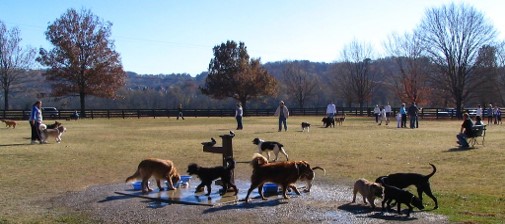Lepto – A New Focus on an Old Disease

Lepto – A New Focus on an Old Disease
Leptospirosis (Lepto for short) is not a new disease. We have known of its existence since the late 1800s in dogs. But the incidence of this disease is increasing in our canine friends, with increased interactions in areas where wildlife roam and livestock graze and live. Urban areas also pose high risk due to high rodent populations. Thus, urban, suburban, and rural dogs are all at risk. In June of 2024, the American Veterinary Medical Association (AVMA) changed its guidelines on vaccination, making this a core vaccination for all dogs. Dogs are not the only ones at risk, however. People also are at risk of infection from the same sources, as well as at risk of infection from their dogs. 
Leptospirosis is a spirochete bacteria. Over 250 types (serovars) have been named, with about 10 of these of significance for the pet population. It is most commonly shed from infected wildlife (racoons, opossums, skunks, mice, and rats) in their urine. In urban areas there is an increased risk due to the high population levels of rodents in these areas. These animals frequently urinate in areas people and pets directly inhabit. In more rural areas, livestock (cows, horses, sheep, goats, and pigs) are all commonly infected and can shed the bacteria in their urine. In 2021 a major outbreak occurred in dogs in California in areas of kennels and daycares. Dogs can be a major source of infection to one another and to people.

Once the Lepto bacteria is shed in the environment, it thrives in areas of standing water and multiplies. Drinking standing water is a direct source of infection. But once the area dries out, the bacteria can persist for months in infected soil. Infection can also happen from bite wounds, exposure to reproductive secretions, and ingestion of infected tissues (eating dead animal parts and pieces). This is a gross but popular habit of many dogs.
Once ingested, there are 3 forms of disease that can develop from this disease.
- Peracute disease – This has a rapid onset and is the most severe form. It often affects younger dogs with a recent ingestion of a large amount of Leptospire toxin produced by the bacteria. This toxin rapidly causes death in a younf and previously healthy animal before liver and kidney disease even happens.
- Acute Disease / Subacute Disease – This is the more classic form of disease that is typically seen about 7 – 14 days after exposure. It can cause high fever, bruising and bleeding, generalized muscle pain, and pain from kidney and / or liver failure. Liver failure may cause jaundice, a yellowing of the skin. Eye inflammation called uveitis may also occur, making the eyes look cloudy and red with squinting.
- Chronic Disease – If a dog survives the acute phase of disease, the chronic stage of disease sets in. This results in recurrent fevers, chronic liver inflammation, chronic kidney disease, inflammation within the eyes (uveitis), poor appetite, and weight loss.
Some dogs will develop a pulmonary (lung) form of the disease with the toxins from the bacteria. This results in Pulmonary Hemorrhage Syndrome with bleeding into the lungs. If this occurs then the prognosis is very poor, with a 70% mortality rate. 80 – 100% of the dogs infected will have damage to the kidneys with elevations of their kidney enzymes in the blood. Excessive thirst is a sign of this when kidney insult is happening. All of these forms of disease can happen in humans when they become infected as well.







Lepto can be treated with antibiotics, but often requires hospitalization and IV fluids to protect the kidneys during infection. Treatment can become costly when hospitalization is needed. Vaccination is by far the best way to help prevent this deadly disease. Two types of vaccines exist, a two-way vaccine (covering two serovars of lepto) and a four-way vaccine (covering four serovars of lepto). It is recommended to use the four-way vaccine for the best protection. This vaccine covers the serovars Canicola, Grippotyphosa, Pomona, and Icterohemorragiae. It will not prevent disease completely but will decrease the severity of disease. Dogs can still become chronic shedders of the disease with vaccination. The newer vaccine formulations are much less reactive than older vaccines that were available. It is no longer true to say that this is a vaccine that causes a lot of vaccine reactions. It is also false that certain breeds are unable to receive the vaccine without problems. Protection is important for all breeds and lifestyles of dogs. Other methods of prevention include clearing free-standing water and practicing pet safe rodent control.
Our feline friends are again off the hook compared with dogs when we consider illness from Lepto. Similar to tick-borne diseases, cats rarely become ill from leptospirosis. However, cats do become infected from ingestion of contaminated water and infected rodents. They do then shed the bacteria into the surrounding area in their urine and further perpetuate the risks of disease to dogs and people.
Due to increasing exposure to infection rates with Leptosporosis, and now decreased vaccine reaction rates, Lepto is now considered a core vaccine along with rabies and distemper for all dogs. If your dog is not current on their Lepto vaccine or has never been vaccinated, let us help protect them and your family from this deadly disease. This is a disease with both a veterinary and public health impact. Make an appointment today!
Sincerely,
Dr. Trisha Metzger (and the rest of the infectious disease busting team at Countryside Animal Clinic)
.jpeg)


